
7 Best Swim Bags for Swimmers
Looking for a swim bag to haul your swim gear? Here are the top picks for the best bags for swimmers on the market.
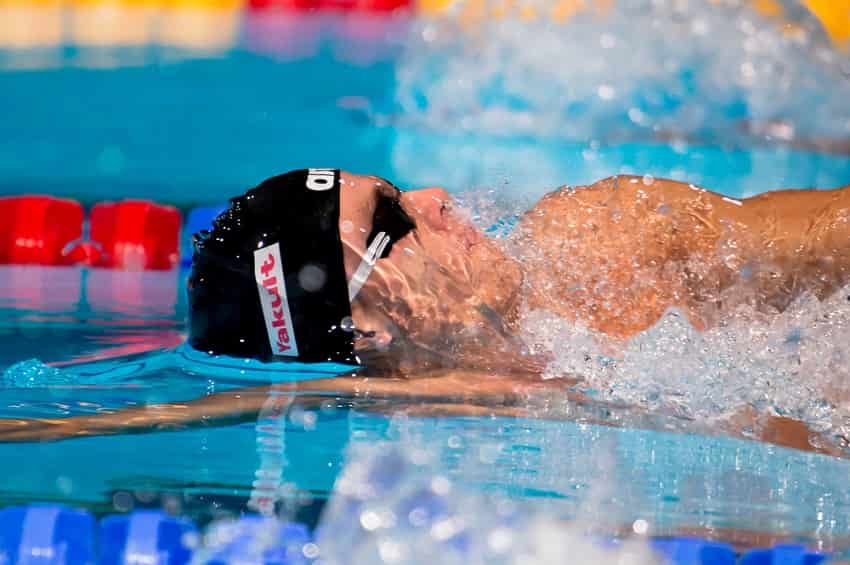
Here’s the swimmer’s guide to swim fins: when to use them, how to pick out a pair that matches your goals in the water, and reviews of some the best swim fins available.
Training with fins is simply the best.
You get to experience speeds that your heroes swim at (or faster). Being able to power through the water at a velocity that you can only dream about doing with regular swimming is intoxicating, and a top reason why we all scramble for them the moment coach scrawls “w. fins” on the whiteboard.
But training with swim fins is more than just going really, really fast.
It can also help us become better swimmers without fins, improve ankle flexibility, and strengthen the weakest part of our kick—the upkick.
In this guide to training with swim fins, we are going to cover a whole bunch of stuff, like:
Let’s do this!
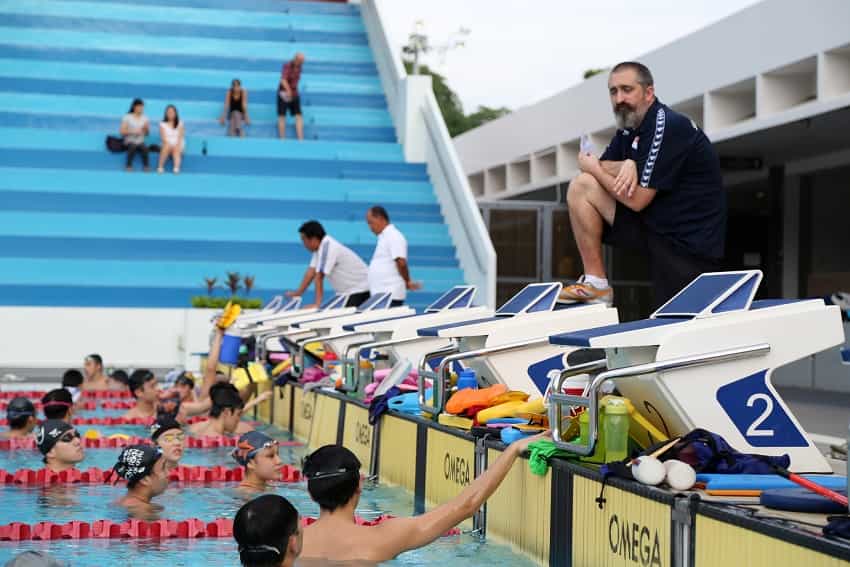
You already know the general effect of strapping the equivalent of a jetpack to your feet:
You go absurdly fast.
Grant Hackett and Michael Phelps, when engaging in a week of going head-to-head in training strapped on fins at the end of a practice and swam :21 seconds low for a 50m free. Long course.
Beyond going quick, according to some research (and our experience) using fins in practice does the following:
Alrighty, let’s start off with the benefits of swimming with fins:
One of my favorite pieces of advice I got from a coach was to use fins during warm-up. Strapping them on at the beginning of the workout helped avoid some unnecessary strain on those all-important shoulders.
Whenever I was fighting off a fresh case of swimmers shoulder during my late teenage and university years I was often instructed to strap on the fins to help ease the strain on my upper body.
This ranged from swimming with fins to doing straight kick, but the premise was simple—remove the load from the shoulders and onto the hips and legs.
Fins can be a great training aid for when your upper body is either injured, or you want to ease into your swim workout.
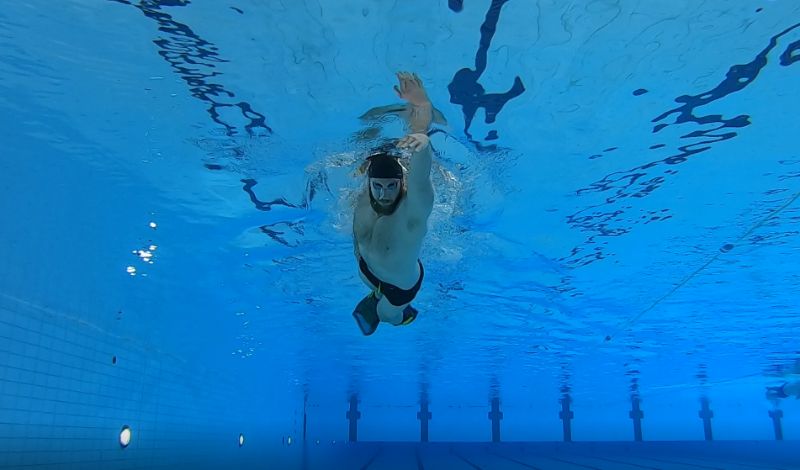
Fins are tools of resistance. Your legs contain the biggest muscles in your body–that added work means that they are getting a harder workout, something that is perfect for increasing overall power and conditioning.
If you wanna go next level with your power and strength work combine your fins with a pair DragSox. It gives you a strange mix of added speed and resistance at the same time compared to your regular kicking speed. Your legs won’t know what hit them.
And lastly, for swimmers who prefer to dangle their legs limply behind them like kelp as they swim along, fins generally help boost the cardio/aerobic nature of their work. Not kicking when you have fins on your feet generally leads them to sinking, so by nature of maintaining any kind of forward propulsion, you have to kick.
Our coaches are always telling us to work on the upwards phase of our kick, but it can often feel a little weird. We’ve become so accustomed to kicking downwards—which is a much more natural kicking motion—than kicking up, which leaves us feeling disjointed and awkward.
The added surface area of fins helps you really feel out the up-kick.
If you really want to work on your up-kick throw some vertical kicking into your practices—you’ll come to appreciate how important it is when kicking vertically, especially with dolphin kick.
Swimming with fins is fast and fun. Flying under and across the water, whether dolphin kicking or swimming, at lightspeed is quite pleasurable.
The speeds we attain are higher, the wakes we create are massive (sorry-not-sorry swimmers in the next lane!), and we get to swim at paces we rarely are able to when straight swimming.
Simple as that.
The importance of ankle flexibility for swimmers is hard to overstate, and is one the most important factors in having a deadly kick. A low range of motion in your feet means that you are kicking water downwards, as opposed to kicking water backwards.
A reason a lot of triathletes and newbie swimmers have such horrendous kick is because they have next to no range of motion in their ankles.
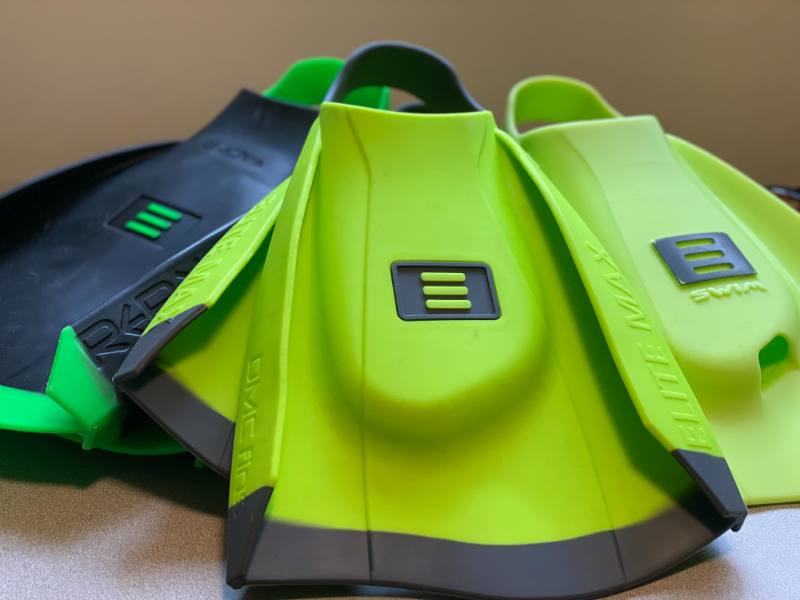
When we are wearing fins you come to understand this—the extra surface area extending to the tip of them provides additional ankle extension and surface area to plant into the water to push you forward.
Fins put your feet into a position where your ankles are largely forced to be pointed/extend, which will help improve overall flexibility in your feet.
If you are using the fins to kick, and not simply dangle behind you, your body will ride higher in the water. It gives you that amazing feeling of skimming across the surface of the pool.
This effect is especially noticed in swimmer’s whose kick isn’t very strong, and therefore tend to sag and bulldoze their way through the water.
Fin-powered swimming shows you the body position you want to attain during your regular swimming and reminds you how crucial it is to work on your kick.
The swimmers who scramble for fins the fastest are usually the ones with the worst kicks. They become dependent on the tool, and can hide their shoddy ankle flexibility behind the raw quad and hamstring power we rely on with fins.
You will never catch up to your fast-kicking teammates by always reaching for the fins every time a kick set comes up.
Every competition warm-up I’ve ever experienced or been on deck for, from summer league to Trials to masters meets, don’t allow their use during warm-ups. Which makes sense. Meet warm-up is already a nightmare, last thing we need is people zipping back and forth with flippers.
Don’t make your pre-competition ritual reliant on them whatsoever unless you are planning on sneaking off to the corner of the dive tank to do some vertical kicking.
I’ve gone through dozens of pairs of fins over the years, and some of them have left some truly unsightly blisters on my feet.
Not fun.
The first time I used DragSox and fins at the same time I walked off of the pool deck with a set of blisters that made it look like I had spent an afternoon dolphin kicking the bottom of the pool.
Case in point:
A photo posted by YourSwimBook (@yourswimbook) on
Picking out a pair of swim fins seems like a no-brainer–pick out the biggest, baddest pair of the bunch!
But if you want to make the most of this piece of swimming equipment, and want to avoid getting bruised heels and blisters, than here is what you need to know about picking out a pair of swim fins for yourself.
When it comes to training with fins, length is the most important thing.
But probably not for the reason you think.
Fins might all look the same, but they should serve a function beyond just going fast. They should match up to what kind of training you are doing.
While we all scramble for the long fins because in our minds long = much faster, this isn’t necessarily the case. The longer your fins, the more difficult it is to kick with any kind of turnover. (Longer, stiffer fins are best used for snorkeling and diving, not swimming.)
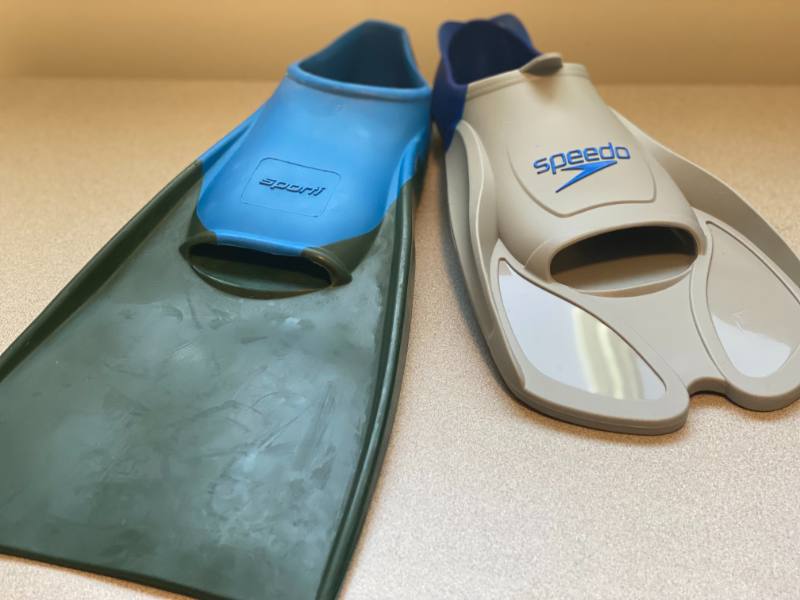
If you take one thing away from this guide, remember this: long fins will collapse your kick frequency, and short fins are border-line pointless for longer, distance-oriented swimming.
In sum–
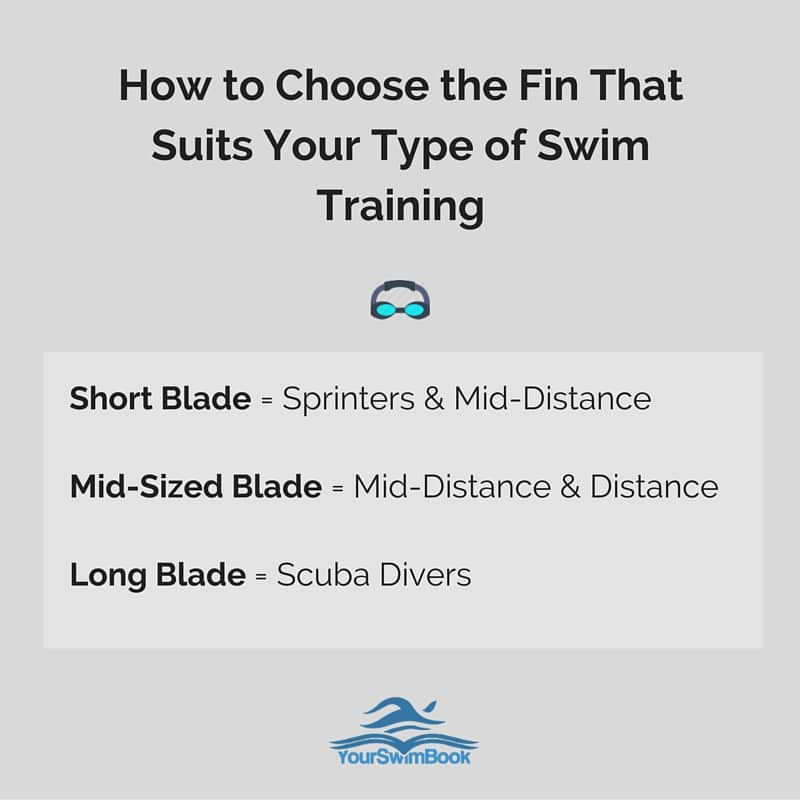
Until recently almost all swim fins designed for competitive swimmers had closed heels. More and more now we are seeing fins that have the open heel, with a strap going around the ankle to keep the fin in place.
Personally I much prefer the open heel fins, as it will usually provide you with a fuller range of motion.
The problem with really rigid fins that have closed heels is that if you have decent ankle flexibility the top of the heel will dig into your Achilles when you are kicking.
In my experience these type of fins also stay on the foot much better, which comes in handy when you are kicking all out, or pushing off the wall.
Another important thing to consider when buying a new pair of fins is how rigid they are. For this reason, I would recommend that you either get your hands on a pair you are thinking of buying to assess the stiffness for yourself.
Zoomers, for instance, one of the most popular set of fins you will find in a swimmer’s bag, are quite rigid and unforgiving. Most diving fins are similarly rigid, and made of a hard plastic.
The more stiff the fins, the harder it will be to kick.
While a stiff fin may be useful for getting fit, or getting a harder workout out of your legs, they promote a slower tempo kick, which doesn’t benefit swimmers who are trying to get faster.
Additionally, really stiff fins tend to dig into the top of your heels as mentioned in the previous point.
One of the things that drive me nuts about using fins is the blisters that sometimes come with their usage. To combat this as an age grouper our coaches had us bring old cotton socks to put on to help mitigate some of the rubbing.
Nowadays there are all types of socks designed specifically for this purpose.
If you are using a more rigid, rubber fin I would recommend getting a pair of socks if you are going to be doing substantial training with your fins on.
More and more high performance fins are being made with silicone these days, and thankfully so.
Silicone rubs and blisters your feet a whole lot less than rubber, which means that you can kick to your heart’s delight without worrying about destroying the skin on your feet.
The suppleness of silicone also promotes a more fluid and natural kicking motion.
There are a metric butt-ton of options out there when it comes to settling on a pair of swim fins. Below are the most popular and highest-rated fins out there.
I’ve used them at varying points over the course of my own career in the water.
For a more complete rundown of the top swim training fins, reference my guide to the best swim training fins, which includes the top swim fins for every kind of swimmer, the pros and cons of each, and more.
These DMC swim fins are the best of the best when it comes to swim training fins.
They are made of a buttery-soft silicone polymer that completely eliminates blisters and also helps create a more natural kicking motion.
They come in a huge range of sizes, from XXS (making them an excellent kids swim fin) up to XL, which fits my feet just fine (I’m a size 14 foot, for reference).
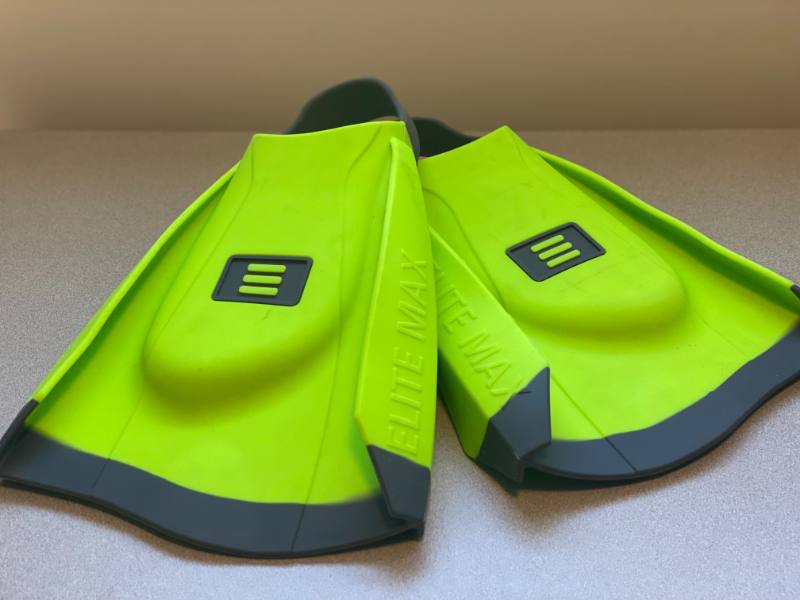
I’ve been using them as my primary swim fins since around 2015 and continue to be amazed by their build quality. The most recent edition of the Elites have V-rails that flare out lightly when kicking, catching more water and generating more propulsion and speed.
The main downside of these fins is that they are pricey–at just under a hundred dollars they are the most expensive swim fins on the pool deck–and are available exclusively at DMC’s website (link below), but if you are looking for the best when it comes to your swim training, the DMC Max Elites are it, and it’s not even really that close.
The Arena Powerfins Pro are another excellent training swim fin. They are made of silicone (almost completely eliminating blisters), have an open-heeled design, and are used by some of the top swimmers on the planet, including elite sprinters Bruno Fratus (BRA) and one of the top female swimmers on the planet, Sarah Sjostrom (SWE).
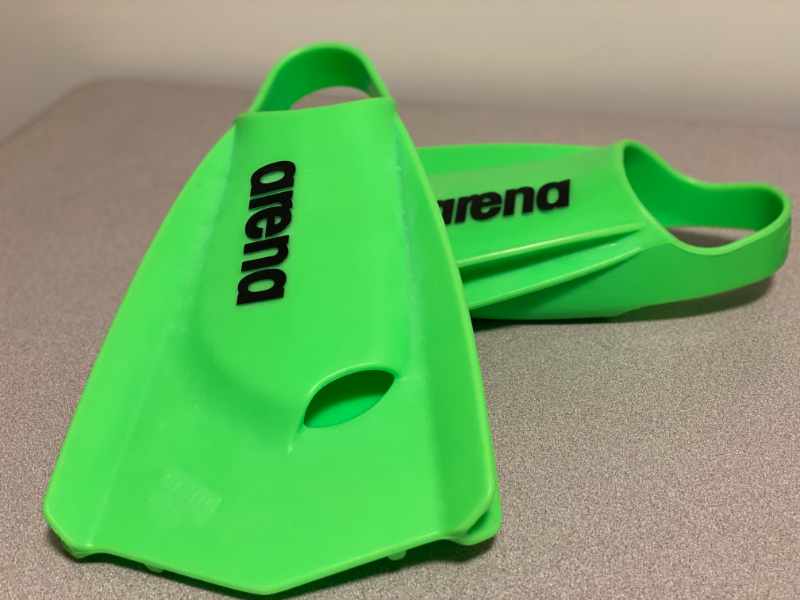
As a bonus, with those bright colors, you won’t have a hard time fishing them out of your swim bag when you head to the pool.
They come in a variety of youth and adult sizes and are available at Amazon and Swim Outlet.
Looking for a budget-friendly long-blade swim training fin? Sporti, Swim Outlet’s in-house swim brand, makes a killer set for around $20.
They are made of rubber, have a closed-heel design, a flexible foot pocket for a comfortable kicking experience, and a longer blade to help build leg muscle and endurance.
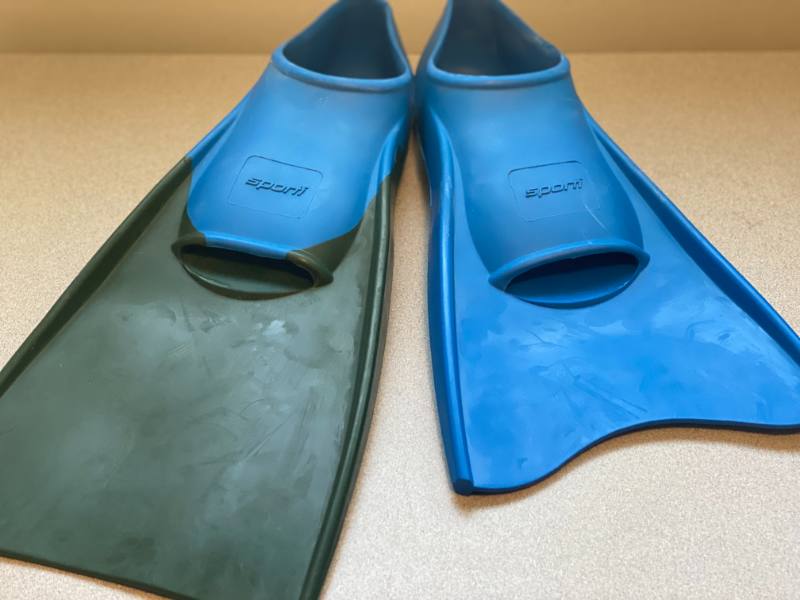
The added material in long blade fins also generates more buoyancy when swimming, making them ideal for swimmers looking to improve body position in the water.
Sporti offers these fins in a short-blade design (as pictured above) as well.
I had an absolute love/hate relationship with these throughout my age group years.
The reason being that they are very stiff to the point of being border-line indestructible.
For sprinters the rigidity is handy, because you can recruit that extra surface right away when you are kicking at high RPM—there is no waiting for the fin to finish its whip before heading back into the other direction. The fin reacts when you do.
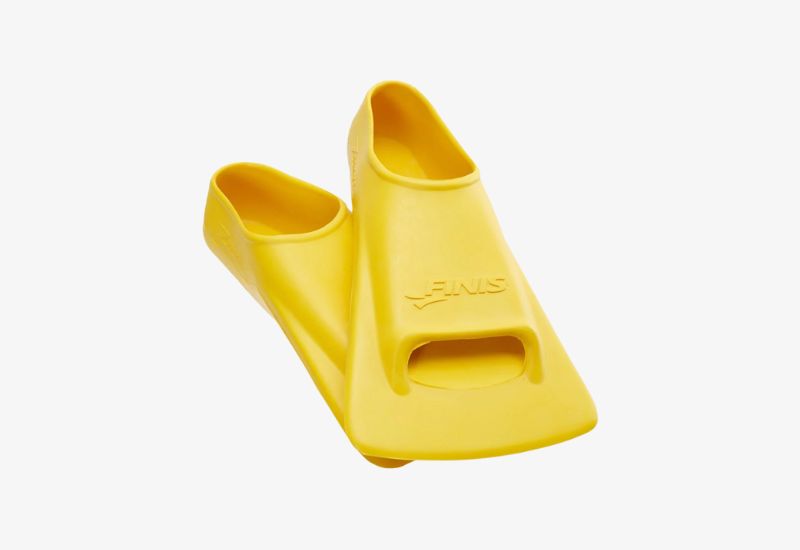
But why I wasn’t fond of them in my age group days was because of the horrendous blisters I would get, meaning I had to wear socks whenever wearing Zoomers fins. (Or maybe coach just didn’t let us use them enough!)
These shortest of short fins have been around forever, and for good reason, they are highly effective.
The DMC Repellors are designed for open water swimming and playing in the surf, with a longer blade length than the Max Elites (mine are about 1.5” longer at the XL size) and a wider chute on the bottom for getting sand and grit out of the fins.
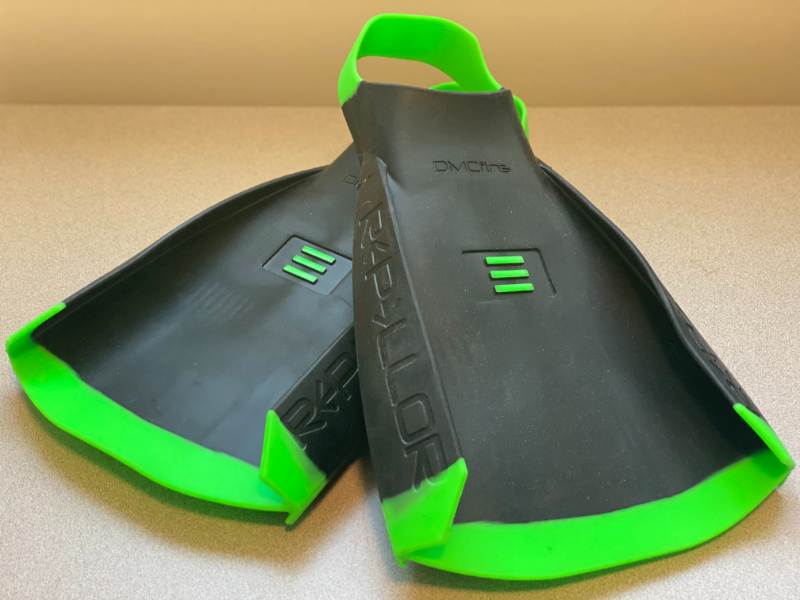
The Repellors are made with that same smooth-as-butter soft silicone polymer as DMC’s other swim fins, have extra treading on the bottom for walking along rocks and slippery surfaces, and DMC offers a set of leg clamps to keep the fins on your feet when getting tossed around in the surf.
While swimming with fins is fun, remember that they are simply another tool in your arsenal.
Think beyond just getting to swim fast when you wear them.
Use your swim fins to help improve ankle flexibility, develop a more balanced kick, fix your body positioning in the water, and of course, drown the swimmers in the next lane with your massive wake.
How to Develop an Unstoppable Freestyle Kick. Ready to develop a legendary flutter kick? Here is everything you need to know to get kickin’.
The Monofin: Your Weapon for a Killer Dolphin Kick. Want to level up your underwaters? Learn how a Monofin is one of the most potent weapons for taking your fly kick to the next level.

Olivier Poirier-Leroy Olivier Poirier-Leroy is the founder of YourSwimLog.com. He is an author, former national level swimmer, two-time Olympic Trials qualifier, and swim coach.

Looking for a swim bag to haul your swim gear? Here are the top picks for the best bags for swimmers on the market.
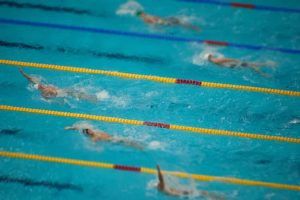
If you are looking for a gift for your favorite swimmer, here’s a guide to the best gifts for swimmers.
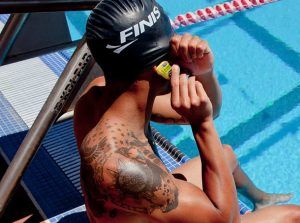
Here’s a quick review on how the FINIS Tempo Trainer Pro can help you become a better swimmer.
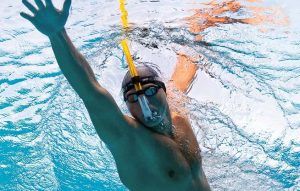
It’s one of the most powerful pieces of swimming gear you own. Here’s how to clean and care for your swim snorkel.
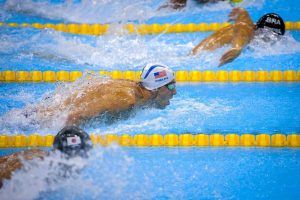
Swimmers always get a little giddy when coach lets them use fins for the main set. Here are 5 things to keep in mind when using your fins.
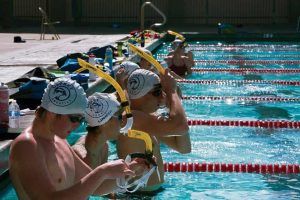
Are you making the most of your swim snorkel? Here are 3 ways to get more from this powerful piece of swim gear.
SITE
SHOP
GUIDES

LANE 6 PUBLISHING LLC © 2012-2024
Join 33,000+ swimmers and swim coaches learning what it takes to swim faster.
Technique tips, training research, mental training skills, and lessons and advice from the best swimmers and coaches on the planet.
No Spam, Ever. Unsubscribe anytime.
